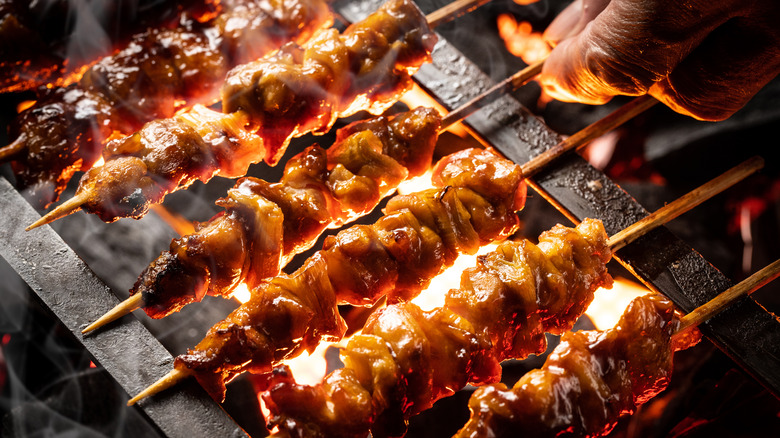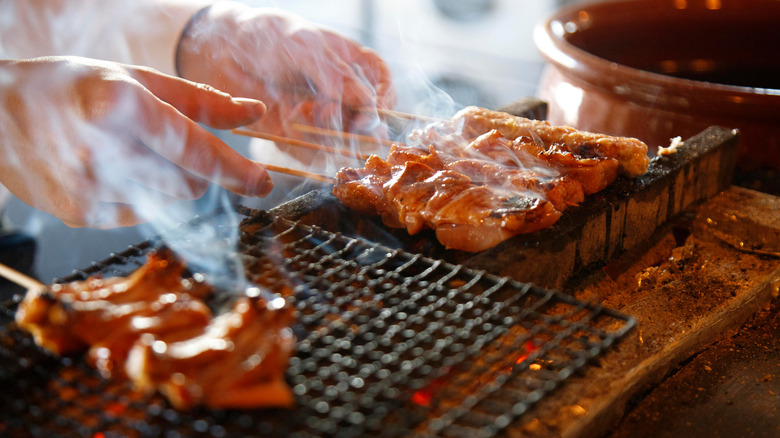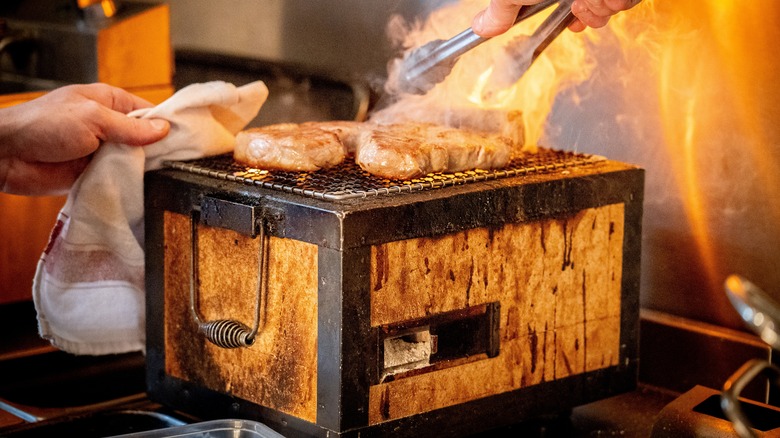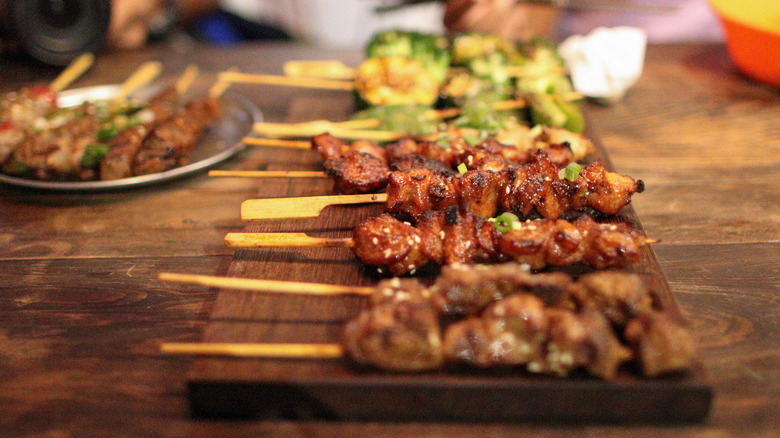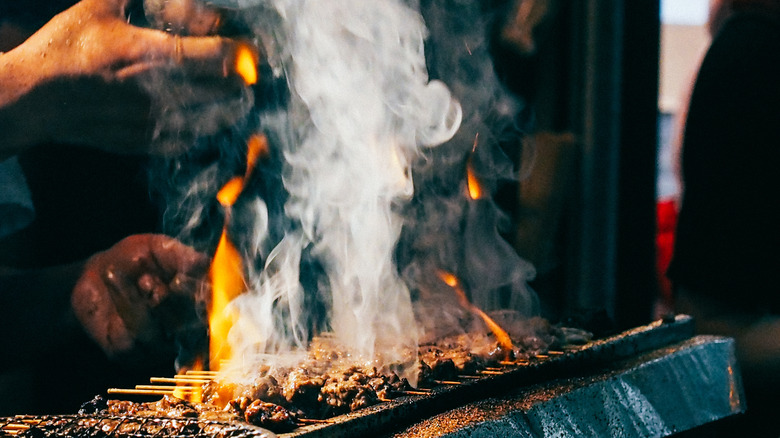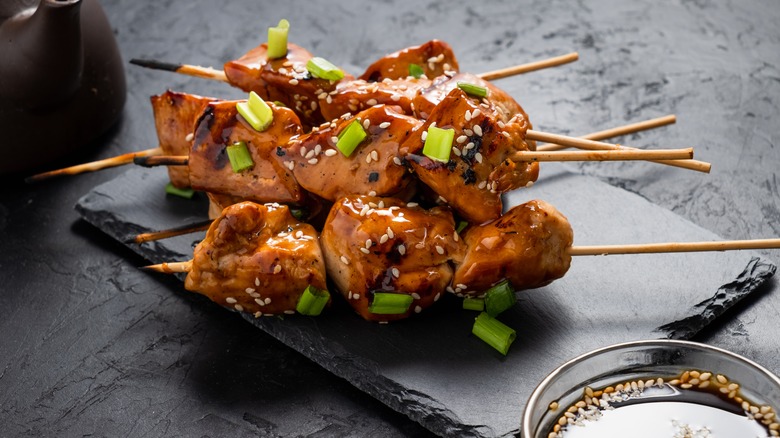An Expert's Guide To Yakitori: The Japanese Grilled Chicken Skewers
Yakitori is a Japanese dish of skewered and grilled chicken, often served alongside a cold glass of beer. Translating to "grilled bird," it's a popular snack commonly found and often made to the customers' specifications at specialty "yakitori-ya" across Japan and bars and restaurants. Traditional yakitori utilizes almost every part of a chicken, including the breast, thighs, gizzards, livers, and skin, often on one long skewer. Inexpensive, flavorful, and relatively easy to make, Yakitori can be replicated in your home after learning some professional instruction.
Hugo Valdez, Culinary Director of Kinjo Enterprises, spoke with Foodie about the proper way to prepare yakitori — how it's made at several of his Atlanta-based restaurants, including Kinjo Room and Yakitori Kona — which, along with traditional yakitori, grills other dishes such as lobster. Before pre-heating your grill, read the six tips that Valdez revealed to us for the most tender, mouthwatering yakitori this side of the Pacific Ocean.
Choosing the right chicken
Like any meal, the quality of the meat you use will significantly impact the taste and texture of your yakitori. "The chicken is the star of the show," according to our expert Hugo Valdez, "and the flavor is really different when it's an all-organic, sustainably raised chicken."
The best bird for your skewers is a "young chicken that's tender and preferably locally raised." Valdez sources his from Springer Mountain Farms in northern Georgia for his restaurants. According to the restauranteur, using a whole chicken is preferred so you can use all the different parts of the bird across your skewers.
Of course, buying a deconstructed chicken or only specific parts of the chicken from the grocery store works as well. Using just the thighs, you can make a type of yakitori called momo or try making tebasaki, which are strictly wings served crispy in pairs with the skin intact. Whatever part or parts of the bird you choose for yakitori makes little difference in the rest of the preparation and cooking processes, so choose whatever works best for you.
Preparing and flavoring your chicken
Whether or not to marinate chicken for yakitori is a hot-button debate among chefs. Traditionally, the meat is seasoned with salt, or "shio," before being cooked over a hot grill. In place of a saucy marinade, old-school yakitori uses a lighter basting sauce called Tare, which is applied during the cooking process and used as a dipping sauce after serving.
At its simplest, tare combines and cooks soy sauce, mirin, sake, and sugar. You can add more depth of flavor to this salty-sweet sauce by first boiling or roasting your chicken carcass into a broth, as Hugo Valdez recommends, along with "carrots, onions, and other spices such as black pepper or ginger." Once the flavor of these heartier ingredients has melded together, add in the soy sauce, mirin, sake, and sugar.
Tare sauce can be made in many different ways, so play around and figure out what you like best. Some of the best advice Valdez gave us is to "have fun, learn the skillset, and then push the boundaries of it."
Prepare the grill
Any stainless steel BBQ will do the trick for grilling yakitori, though in Japan, this bar food snack is traditionally cooked over a charcoal grill. "The charcoal or "binchotan" is such an important part of yakitori process," says Hugo Valdez, "binchotan coal burns a lot hotter than regular coal, so tending to the grill and focusing on the cooking process is really important." Binchotan also differs from regular lump charcoal because it burns longer, cleaner, and without odor,making it a far superior choice for cooking.
There are multiple grilling hacks when barbecuing, but for yakitori, you'll want to ensure the grill is nice and hot before cooking on it, especially if you are choosing to cook it on a charcoal grill. Some are admittedly better than others, but many great options exist, including tabletop specialty yakitori grills. The Konro ceramic yakitori grill is among the best and highly recommended by Valdez.
Prepare the skewers
While reusable metal or steel skewers will do the trick, yakitori is usually served on 7 to 8-inch bamboo sticks. Hugo Valdez explains, "Traditional bamboo skewers, referred to as kushi, come in various lengths and can also be made out of Japanese cypress." Instead of metal, bamboo helps the meat maintain its shape while not transferring too much heat to the inside, which would overcook the small chicken pieces. Skewer as many small pieces of the bird as you can onto one stick, giving yourself enough room on the bottom to hold onto afterward.
Soaking your skewers before cooking is another debate amongst professional yakitori chefs. Valdez recommends not soaking them, as the moisture could affect how the meat is cooked. To avoid flare-ups or your wooden sticks burning over an open flame, purchase thicker, high-quality sticks with more heat tolerance. Further, place the ends of your skewers away from the open flame or put layers of tin foil on your grill to rest the ends of the skewers on. Make sure the meat stays over the open flame and that only the exposed end of the skewer is resting above the tin foil. If all else fails and you find that your skewers are burning or singeing beyond being able to hold onto them, soak your wooden skewers for 30 minutes before grilling.
Cooking the chicken
Now it's finally time to cook your chicken. Place the skewers over the flame once your grill is set on a comfortable medium to medium-low heat. All of your chicken should be about the same size so that they are all done cooking at the same time. You don't want yakitori with small burnt cuts of chicken next to larger pieces still raw on the inside.
Slowly baste your chicken with your tare sauce, spraying small amounts at a time or brushing directly onto the meat. If you are not using a tare sauce, or otherwise marinating it, you will want to spray the meat with some sort of liquid to keep the meat's moisture. Typically, this is done with sake, one of the four main ingredients used in tare sauce.
Once the chicken begins to cook, Hugo Valdez recommends fanning the flame. "The fan helps the charcoal rise in temperature and get a better sear on the chicken or vegetables," he adds, " Fanning will also tilt the flame that builds up so it doesn't add a bitter flavor to your protein."
Yakitori is typically made to order in small batches, cooking for about 6-10 minutes total. Flip your skewers over once halfway through to get a nice char on each side. Heat until cooked all the way through, but if you don't have a meat thermometer, you can use a cake tester.
Serve and enjoy
Here's where your sauce comes into play: "Before serving, give the skewer one last dip or baste of your tare sauce," says Hugo Valdez. The savory, charred grilled chicken absorbs the vinegary, sweet tare sauce and flirts with every tastebud with that first bite.
Though yakitori is usually a snack served with beer, it can also be a hearty and healthy dinner. Along with chicken, you can also put vegetables such as shiitake mushrooms, squash, eggplant, or shishito peppers on your skewers. This turns your yakitori into "kushiyaki". Valdez gives us his recommendations, adding, "some of the traditional skewers include chicken thigh with scallion, chicken tenders with shiso and plum sauce, chicken hearts, wings, and tail bone." Again, it's all about being inventive and finding what you like best.
Alongside the skewers, "rice balls like onigiri or cucumber salad are always traditional sides," Valdez tells us, "miso soup is also a good idea, and black sesame or matcha ice cream at the end is nice as well." Because every perfect meal should end with a sweet treat.
